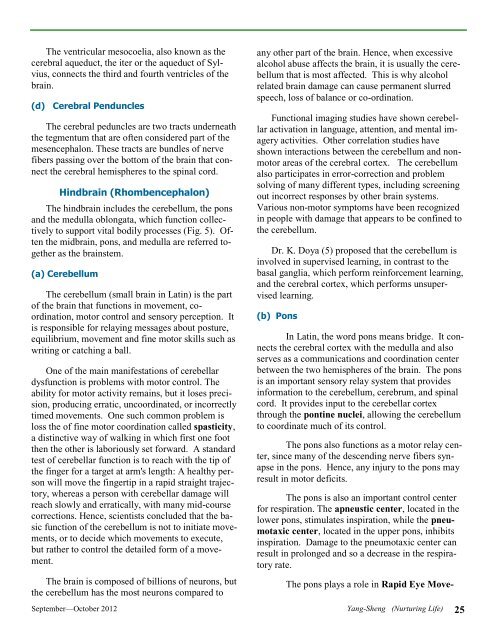Download - Yang-Sheng
Download - Yang-Sheng
Download - Yang-Sheng
You also want an ePaper? Increase the reach of your titles
YUMPU automatically turns print PDFs into web optimized ePapers that Google loves.
The ventricular mesocoelia, also known as the<br />
cerebral aqueduct, the iter or the aqueduct of Sylvius,<br />
connects the third and fourth ventricles of the<br />
brain.<br />
(d) Cerebral Penduncles<br />
The cerebral peduncles are two tracts underneath<br />
the tegmentum that are often considered part of the<br />
mesencephalon. These tracts are bundles of nerve<br />
fibers passing over the bottom of the brain that connect<br />
the cerebral hemispheres to the spinal cord.<br />
Hindbrain (Rhombencephalon)<br />
The hindbrain includes the cerebellum, the pons<br />
and the medulla oblongata, which function collectively<br />
to support vital bodily processes (Fig. 5). Often<br />
the midbrain, pons, and medulla are referred together<br />
as the brainstem.<br />
(a) Cerebellum<br />
The cerebellum (small brain in Latin) is the part<br />
of the brain that functions in movement, coordination,<br />
motor control and sensory perception. It<br />
is responsible for relaying messages about posture,<br />
equilibrium, movement and fine motor skills such as<br />
writing or catching a ball.<br />
One of the main manifestations of cerebellar<br />
dysfunction is problems with motor control. The<br />
ability for motor activity remains, but it loses precision,<br />
producing erratic, uncoordinated, or incorrectly<br />
timed movements. One such common problem is<br />
loss the of fine motor coordination called spasticity,<br />
a distinctive way of walking in which first one foot<br />
then the other is laboriously set forward. A standard<br />
test of cerebellar function is to reach with the tip of<br />
the finger for a target at arm's length: A healthy person<br />
will move the fingertip in a rapid straight trajectory,<br />
whereas a person with cerebellar damage will<br />
reach slowly and erratically, with many mid-course<br />
corrections. Hence, scientists concluded that the basic<br />
function of the cerebellum is not to initiate movements,<br />
or to decide which movements to execute,<br />
but rather to control the detailed form of a movement.<br />
The brain is composed of billions of neurons, but<br />
the cerebellum has the most neurons compared to<br />
any other part of the brain. Hence, when excessive<br />
alcohol abuse affects the brain, it is usually the cerebellum<br />
that is most affected. This is why alcohol<br />
related brain damage can cause permanent slurred<br />
speech, loss of balance or co-ordination.<br />
Functional imaging studies have shown cerebellar<br />
activation in language, attention, and mental imagery<br />
activities. Other correlation studies have<br />
shown interactions between the cerebellum and nonmotor<br />
areas of the cerebral cortex. The cerebellum<br />
also participates in error-correction and problem<br />
solving of many different types, including screening<br />
out incorrect responses by other brain systems.<br />
Various non-motor symptoms have been recognized<br />
in people with damage that appears to be confined to<br />
the cerebellum.<br />
Dr. K. Doya (5) proposed that the cerebellum is<br />
involved in supervised learning, in contrast to the<br />
basal ganglia, which perform reinforcement learning,<br />
and the cerebral cortex, which performs unsupervised<br />
learning.<br />
(b) Pons<br />
In Latin, the word pons means bridge. It connects<br />
the cerebral cortex with the medulla and also<br />
serves as a communications and coordination center<br />
between the two hemispheres of the brain. The pons<br />
is an important sensory relay system that provides<br />
information to the cerebellum, cerebrum, and spinal<br />
cord. It provides input to the cerebellar cortex<br />
through the pontine nuclei, allowing the cerebellum<br />
to coordinate much of its control.<br />
The pons also functions as a motor relay center,<br />
since many of the descending nerve fibers synapse<br />
in the pons. Hence, any injury to the pons may<br />
result in motor deficits.<br />
The pons is also an important control center<br />
for respiration. The apneustic center, located in the<br />
lower pons, stimulates inspiration, while the pneumotaxic<br />
center, located in the upper pons, inhibits<br />
inspiration. Damage to the pneumotaxic center can<br />
result in prolonged and so a decrease in the respiratory<br />
rate.<br />
The pons plays a role in Rapid Eye Move-<br />
September—October 2012 <strong>Yang</strong>-<strong>Sheng</strong> (Nurturing Life) 25













